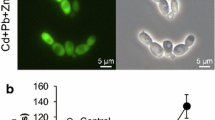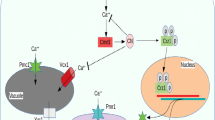Abstract
Yeast Saccharomyces cerevisiae is an ideal model organism for studying molecular mechanisms of the stress response provoked by metals. In this work, yeast cells response to iron (Fe3+) or lead (Pb2+) exposure was tested and compared. Survival test was used to determine testing doses of metal ions—for Fe3+ it was 4 mM and for Pb2+ 8 mM. These (high, over-loaded) doses provoked comparable values of growth inhibition, but different values in vitality measurement. The percentage of metabolically active cells, determined by fluorescent FUN-1 dye, was lower in Pb2+ than in Fe3+ treated cells. Besides, endogenous antioxidant defence systems in the cells treated with Pb2+ were less efficient compared to Fe3+. At the mitochondrial level, the effects of metal ions were in correlation with the results of cell metabolic activity. The mitochondrial proteome of Pb2+ treated cells showed the domination of protein downregulation. Yeast cells treated either with Fe3+ or Pb2+ shared 19 common significantly changed proteins. The affected proteins were involved in different cellular process and amongst them only five proteins belong to energy and carbohydrate metabolism, and protein biosynthesis. Based on all obtained results, it is possible to conclude that the effects of Fe3+ and Pb2+ on yeast cells show rather specific patterns of toxicity and stress response.





Similar content being viewed by others
Data Availability
The authors confirm that the data supporting the findings of this study are available within the article. Any additional data are available from the corresponding author.
References
He ZL, Yang XE, Stoffella PJ (2005) Trace elements in agroecosystems and impacts on the environment. J Trace Elem Med Biol 19(2–3):125–140. https://doi.org/10.1016/j.jtemb.2005.02.010
Jan AT, Azam M, Siddiqui K, Ali A, Choi I, Haq QMR (2015) Heavy metals and human health: mechanistic insight into toxicity and counter defense system of antioxidants. Int J MolSci 16(12):29592–29630. https://doi.org/10.3390/ijms161226183
Wysocki R, Tamas M (2010) How Saccharomyces cerevisiae copes with toxic metals and metalloids. FEMS Microbiol Rev 34(6):925–951. https://doi.org/10.1111/j.1574-6976.2010.00217.x
Piloni NE, Fermandez V, Videla LA, Puntarulo S (2013) Acute iron overload and oxidative stress in brain. Toxicology 314(1):174–182. https://doi.org/10.1016/j.tox.2013.09.015
Yazgan O, Krebs JE (2012) Mitochondrial and nuclear genomic integrity after oxidative damage in Saccharomyces cerevisiae. Front Biosci (Landmark Ed) 17:1079–1093. https://doi.org/10.2741/3974
Herrero E, Ros J, Belli G, Cabiscol E (2008) Redox control and oxidative stress in yeast cells. BiochimBiophysActa 1780(11):1217–1235. https://doi.org/10.1016/j.bbagen.2007.12.004
Ballatori N (2002) Transport of toxic metals by molecular mimicry. Environ Health Perspect 110(Suppl 5):689–694. https://doi.org/10.1289/ehp.02110s5689
Jarup L (2003) Hazards of heavy metal contamination. Br Med Bull 68:167–182. https://doi.org/10.1093/bmb/ldg032
Ćurko-Cofek B, Grubić Kezele T, Barac-Latas V (2017) Hepcidin and metallothioneins as molecular base for sex-dependent differences in clinical course of experimental autoimmune encephalomyelitis in chronic iron overload. Med Hypotheses 107:51–54. https://doi.org/10.1016/j.mehy.2017.07.022
Bleackley MR, Macgillivray RT (2011) Transition metal homeostasis: from yeast to human disease. Biometals 24(5):785–809. https://doi.org/10.1007/s10534-011-9451-4
Musci G, Polticelli F, Bonaccorsi di Patti MC (2014) Ceruloplasmin-ferroportin system of iron traffic in vertebrates. World J BiolChem 5(2):204–215. https://doi.org/10.4331/wjbc.v5.i2.204
Chen C, Paw BH (2012) Cellular and mitochondrial iron homeostasis in vertebrates. BiochimBiophysActa 1823:1459–1467. https://doi.org/10.1016/j.bbamcr.2012.01.003
Ye H, Rouault TA (2010) Human iron-sulfur cluster assembly, cellular iron homeostasis, and disease. Biochemistry 49:4945–4956. https://doi.org/10.1021/bi1004798
Levi S, Rovida E (2009) The role of iron in mitochondrial function. BiochimBiophysActa 1790:629–636. https://doi.org/10.1016/10.1016/j.bbagen.2008.09.008
Farina M, Avila DS, da Rocha JB, Aschner M (2013) Metals, oxidative stress and neurodegeneration: a focus on iron, manganese and mercury. NeurochemInt 62(5):575–594. https://doi.org/10.1016/j.neuint.2012.12.006
Kim JJ, Kim YS, Kumar V (2019) Heavy metal toxicity: an update of chelating therapeutic strategies. J Trace Elem Med Biol 54:226–231. https://doi.org/10.1016/j.jtemb.2019.05.003
Matović V, Buha A, Ðukić-Ćosić D, Bulat Z (2015) Insight into the oxidative stress induced by lead and/or cadmium in blood, liver and kidneys. Food ChemToxicol 78:130–140. https://doi.org/10.1016/j.fct.2015.02.011
Flora G, Gupta D, Tiwari A (2012) Toxicity of lead: a review with recent updates. InterdiscipToxicol 5:47–58. https://doi.org/10.2478/v10102-012-0009-2
Eid A, Zawia N (2016) Consequences of lead exposure, and it’s emerging role as an epigenetic modifier in the aging brain. NeuroToxicol 56:254–261. https://doi.org/10.1016/j.neuro.2016.04.006
Moteshareie H, Hajikarimlou M, Mulet Indrayanti A, Burnside D, Paula Dias A, Lettl C et al (2018) Heavy metal sensitivities of gene deletion strains for ITT1 and RPS1A connect their activities to the expression of URE2, a key gene involved in metal detoxification in yeast. PLoS ONE 13(9):e0198704. https://doi.org/10.1371/journal.pone.0198704
Hosiner D, Gerber S, Lichtenberg-Frate H, Glaser W, Schüller C, Klipp E (2014) Impact of acute metal stress in Saccharomyces cerevisiae. PLoS ONE 9(1):e83330. https://doi.org/10.1371/journal.pone.0083330
Kwolek-Mirek M, Zadrag-Tecza R (2014) Comparison of methods used for assessing the viability and vitality of yeast cells. FEMS Yeast Res 14(7):1068–1079. https://doi.org/10.1111/1567-1364.12202
Wu X, Hasan MA, Chen JY (2014) Pathway and network analysis in proteomics. J TheorBiol 362:44–52. https://doi.org/10.1016/j.jtbi.2014.05.031
Gómez-Serrano M, Camafeita E, Loureiro M, Peral B (2018) Mitoproteomics: tackling mitochondrial dysfunction in human disease. Oxid Med Cell Longev. https://doi.org/10.1155/2018/1435934
Morgenstern M, Stiller SB, Lübbert P, Peikert CD, Dannenmaier S, Drepper F et al (2017) Definition of a high-confidence mitochondrial proteome at quantitative scale. Cell Rep 19(13):2836–2852. https://doi.org/10.1016/j.celrep.2017.06.014
Pagliarini DJ, Calvo SE, Chang B, Sheth SA, Vafai SB, Ong SE et al (2008) A mitochondrial protein compendium elucidates complex I disease biology. Cell 134(1):112–123. https://doi.org/10.1016/j.cell.2008.06.016
Prokisch H, Scharfe C, Camp DG II, Xiao W, David L, Andreoli C et al (2004) Integrative analysis of the mitochondrial proteome in yeast. PLoSBiol 2(6):795–804. https://doi.org/10.1371/journal.pbio.0020160
Pearce DA, Sherman F (1999) Toxicity of copper, cobalt, and nickel salts is dependent on histidine metabolism in the yeast Saccharomyces cerevisiae [published correction appears in J Bacteriol 1999;181(21):6856]. J Bacteriol 181(16):4774–4779
Zakrajšek T, Raspor P, Jamnik P (2011) Saccharomyces cerevisiae in the stationary phase as a model organism—characterization at cellular and proteome level. J Proteom 74(12):2837–2845. https://doi.org/10.1016/j.jprot.2011.06.026
Jakubowski W, Bartosz G (1997) Estimation of oxidative stress in Saccharomyces cerevisiae with fluorescent probes. Int J Biochem Cell Biol 29(11):1297–1301. https://doi.org/10.1016/S1357-2725(97)00056-3
Zinser E, Daum G (1995) Isolation and biochemical characterization of organelles from the yeast, Saccharomyces cerevisiae. Yeast 11(6):493–536. https://doi.org/10.1002/yea.320110602
Čanadi Jurešić G, Blagović B (2011) The influence of fermentation conditions and recycling on the phospholipid and fatty acid composition of the brewer’s yeast plasma membranes. Folia Microbiol 56(3):215–224. https://doi.org/10.1007/s12223-011-0040-2
Bradford MM (1976) A rapid and sensitive method for the quantitation of microgram quantities of protein utilizing the principle of protein-dye binding. Anal Biochem 72:248–254
Gorg A (1991) Two-dimensional electrophoresis. Nature 349:545–546. https://doi.org/10.1038/349545a0
Perkins DN, Pappin DJ, Creasy DM, Cottrell JS (1999) Probability-based protein identification by searching sequence databases using mass spectrometry data. Electrophoresis 20(18):3551–3567. https://doi.org/10.1002/(SICI)1522-2683(19991201)20:18%3c3551::AID-ELPS3551%3e3.0.CO;2-2
The UniProt Consortium (2019) UniProt: a worldwide hub of protein knowledge. Nucleic Acids Res 47(D1):D506–D515. https://doi.org/10.1093/nar/gky1049
Holmes-Hampton GP, Jhurry ND, McCormick SP, Lindahl PA (2012) Iron content of Saccharomyces cerevisiae cells grown under iron-deficient and iron-overload conditions. Biochemistry 52(1):105–114. https://doi.org/10.1021/bi3015339
Chen C, Wang J (2007) Response of Saccharomyces cerevisiae to lead ion stress. ApplMicrobiol Biotech 74(3):683–687. https://doi.org/10.1007/s00253-006-0678-x
Sousa CA, Soares EV (2014) Mitochondria are the main source and one of the targets of Pb (lead)-induced oxidative stress in the yeast Saccharomyces cerevisiae. ApplMicrobiolBiotechnol 98(11):5153–5160. https://doi.org/10.1007/s00253-014-5631-9
Yuan X, Tang C (1999) DNA damage and repair in yeast (Saccharomyces cerevisiae) cells exposed to lead. J Environ Sci Health Part A 34(5):1117–1128. https://doi.org/10.1080/10934529909376885
Millard PJ, Roth BL, Thi HP, Yue ST, Haugland RP (1997) Development of the FUN-1 family of fluorescent probes for vacuole labelling and viability testing of yeasts. Appl Environ Microbiol 63(7):2897–2905
Van der Heggen M, Martins S, Flores G, Soares EV (2010) Lead toxicity in Saccharomyces cerevisiae. ApplMicrobiolBiotechnol 88:1355–1361. https://doi.org/10.1007/s00253-010-2799-5
Malina C, Larsson C, Nielsen J (2018) Yeast mitochondria: an overview of mitochondrial biology and the potential of mitochondrial systems biology. FEMS Yeast Res 18(5):040. https://doi.org/10.1093/femsyr/foy040
Shenton D, Smirnova JB, Selley JN, Carroll K, Hubbard SJ, Pavitt GD, Ashe MP, Grant CM (2006) Global translational responses to oxidative stress impact upon multiple levels of protein synthesis. J BiolChem 281(39):29011–29021. https://doi.org/10.1074/jbc.M601545200
Temple MD, Perrone GG, Dawes IW (2005) Complex cellular responses to reactive oxygen species. Trends Cell Biol 15(6):319–326. https://doi.org/10.1016/j.tcb.2005.04.003
Shenton D, Grant CM (2003) Protein S-thiolation targets glycolysis and protein synthesis in response to oxidative stress in the yeast Saccharomyces cerevisiae. Biochem J 374:513–519. https://doi.org/10.1042/BJ20030414
Opalińska M, Meisinger C (2015) Metabolic control via the mitochondrial protein import machinery. CurrOpin Cell Biol 33:42–48. https://doi.org/10.1016/j.ceb.2014.11.001
Justinić I, Katić A, Uršičić D, Ćurko-Cofek B, Blagović B, Čanadi Jurešić G (2020) Combining proteomics and lipid analysis to unravel Confidor® stress response in Saccharomyces cerevisiae. Environ Toxicol 35(3):346–358. https://doi.org/10.1002/tox.22870
Shi J, Feng H, Lee J, Chen WN (2013) Comparative proteomics profile of lipid-cumulating oleaginous yeast: an iTRAQ-Coupled 2-D LC-MS/MS analysis. PLoS ONE 8(12):e85532. https://doi.org/10.1371/journal.pone.0085532
Kim HE, Grant AR, Simic MS, Kohnz RA, Nomura DK, Durieux J et al (2016) Lipid biosynthesis coordinates a mitochondrial-to-cytosolic stress response. Cell 166(6):1539-1552.e16. https://doi.org/10.1016/j.cell.2016.08.027
Cadenas E, Davies KJA (2000) Mitochondrial free radical generation, oxidative stress, and aging. Free RadicBiol Med 29(3–4):222–230. https://doi.org/10.1016/S0891-5849(00)00317-8
Ohlmeier S, Kastaniotis A, Hiltunen JK, Bergmann U (2004) The yeast mitochondrial proteome, a study of fermentative and respiratory growth. J BiolChem 279:3956–3979. https://doi.org/10.1074/jbc.M310160200
Olin-Sandoval V, Yu JSL, Miller-Fleming L et al (2019) Lysine harvesting is an antioxidant strategy and triggers underground polyamine metabolism. Nature 572:249–253. https://doi.org/10.1038/s41586-019-1442-6
Zabriskie TM, Jackson MD (2000) Lysine biosynthesis and metabolism in fungi. Nat Prod Rep 17(1):85–97. https://doi.org/10.1039/A801345D
Nielsen J (2019) Yeast cells handle stress by reprogramming their metabolism. Nature 572:184–185. https://doi.org/10.1038/d41586-019-02288-y
Acknowledgements
This work has been supported by University of Rijeka, Project No. 813.10.1113.
Funding
This work has been supported by University of Rijeka, Project No. 813.10.1113.
Author information
Authors and Affiliations
Contributions
Conceptualization, GČJ and PJ; methodology, formal analysis, GČJ, BĆC, MB, NM; investigation, GČJ; resources, BĆC; writing—original draft preparation, GČJ and PJ; writing—review and editing, BĆC. GČJ; visualization, BĆC and GČJ; supervision, PJ and BB; project administration, BB. All authors have read and agreed to the published version of the manuscript.
Corresponding author
Ethics declarations
Conflict of interest
All authors have declared no competing interests.
Additional information
Publisher's Note
Springer Nature remains neutral with regard to jurisdictional claims in published maps and institutional affiliations.
Supplementary Information
Below is the link to the electronic supplementary material.
Rights and permissions
About this article
Cite this article
Čanadi Jurešić, G., Ćurko-Cofek, B., Barbarić, M. et al. Response of Saccharomyces cerevisiae W303 to Iron and Lead Toxicity in Overloaded Conditions. Curr Microbiol 78, 1188–1201 (2021). https://doi.org/10.1007/s00284-021-02390-3
Received:
Accepted:
Published:
Issue Date:
DOI: https://doi.org/10.1007/s00284-021-02390-3




